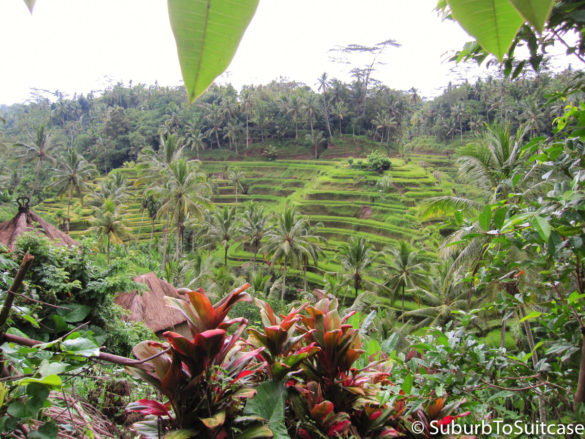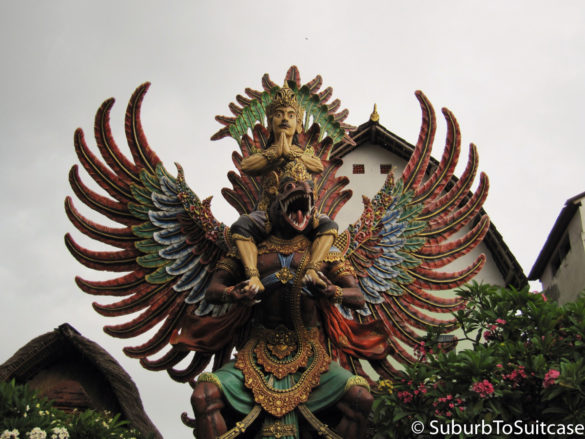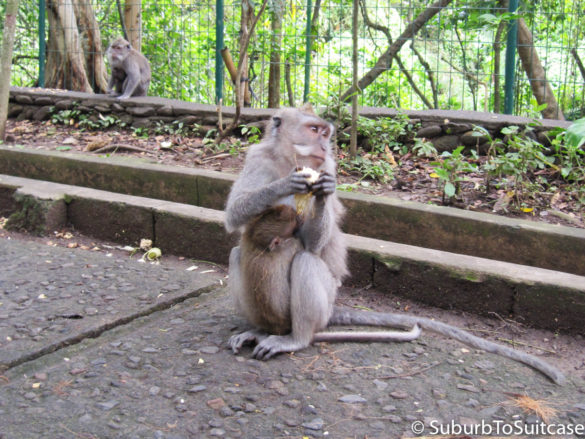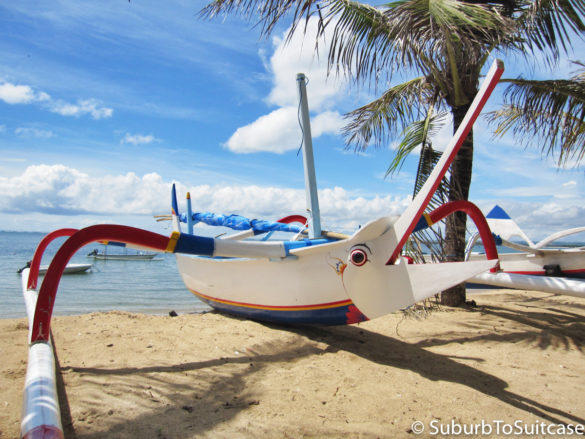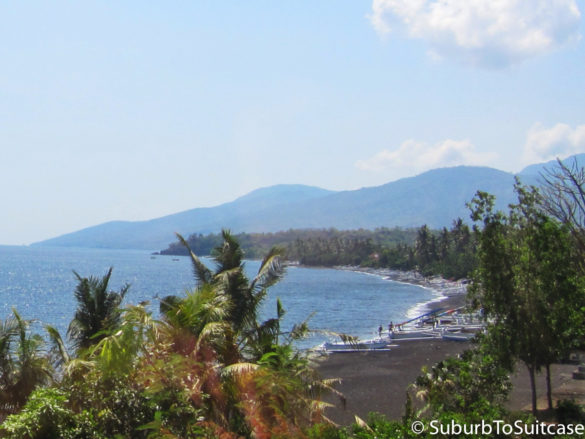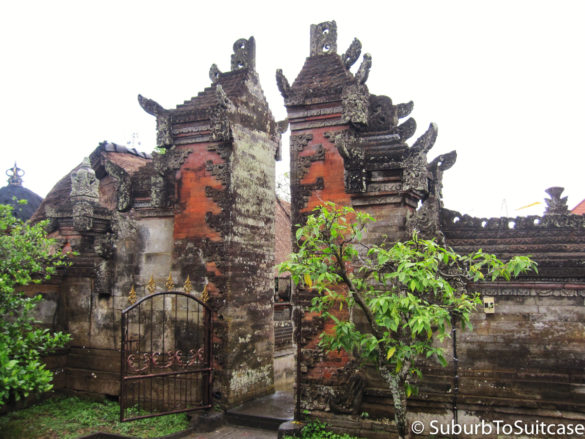Six flights plus 20,000 air miles equals one unforgettable adventure. It took me two days to reach Indonesia from the US but it was worth the compression socks (which worked like a charm, by the way!), airport showers and various time zone changes along the way. The objective for my first trip to Bali was to complete my Divemaster course, but my actual experience was so much more. I was able to meet some wonderful new friends, learn about the local culture, practice a few new Indonesian words and gain a greater appreciation for rice and cabbage. Since my initial trip, I have returned several more times for underwater photography and even for my honeymoon, but this travelogue is geared toward my initial experience.
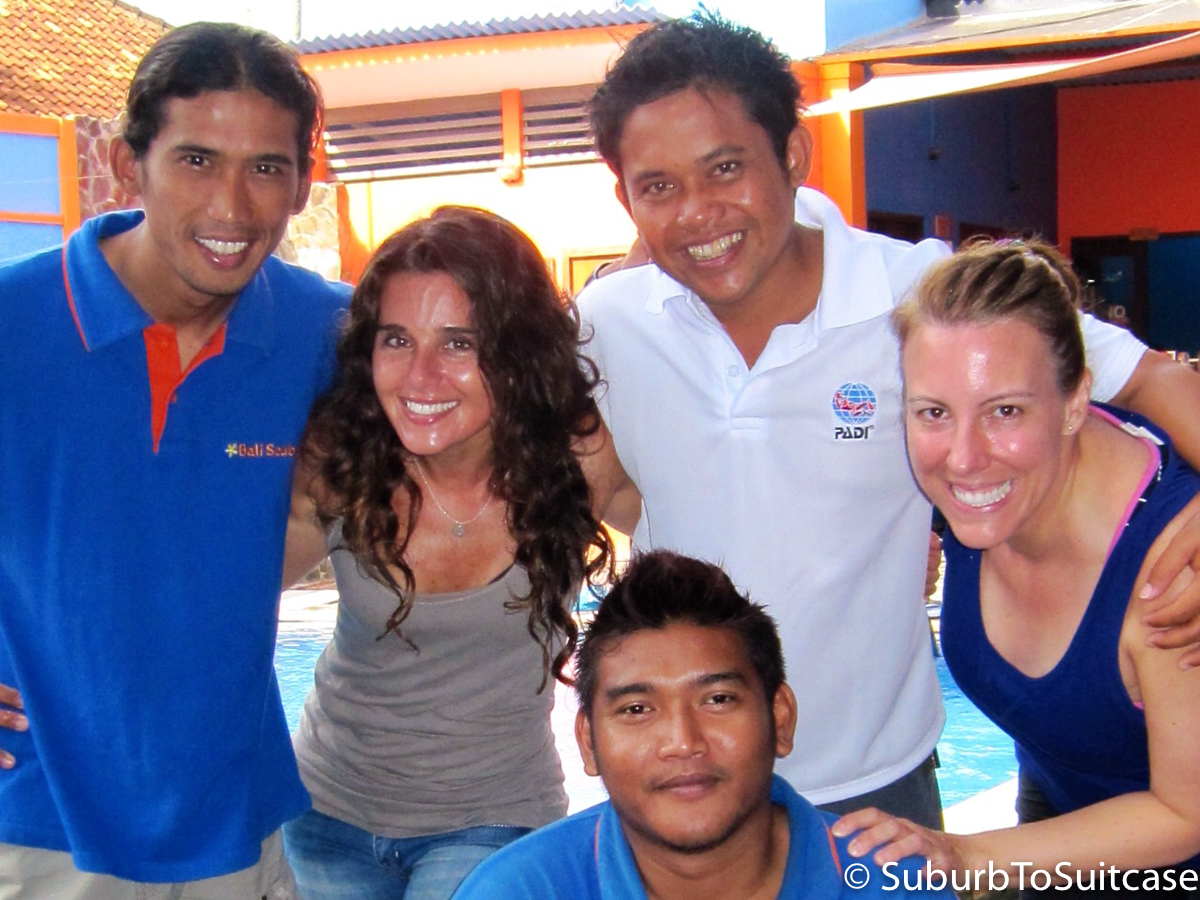
My Divemaster Squad in 2014
For my divemaster program, I was based in Sanur (a 30-60 minute drive from the Denpasar airport depending on traffic) and for what I intended to accomplish, this was a perfect, centrally located area. Sanur offers many reasonably priced accommodations in the form of small hotels, guest houses and homestays. The beach, restaurants, groceries, shopping, yoga, doctors, pharmacies, money changes, travel bookers, etc. are just 5-45 minutes away on foot with an overwhelming number of taxis and bemos (rustic local shuttle vans) available. Most guest houses offer bicycles too.
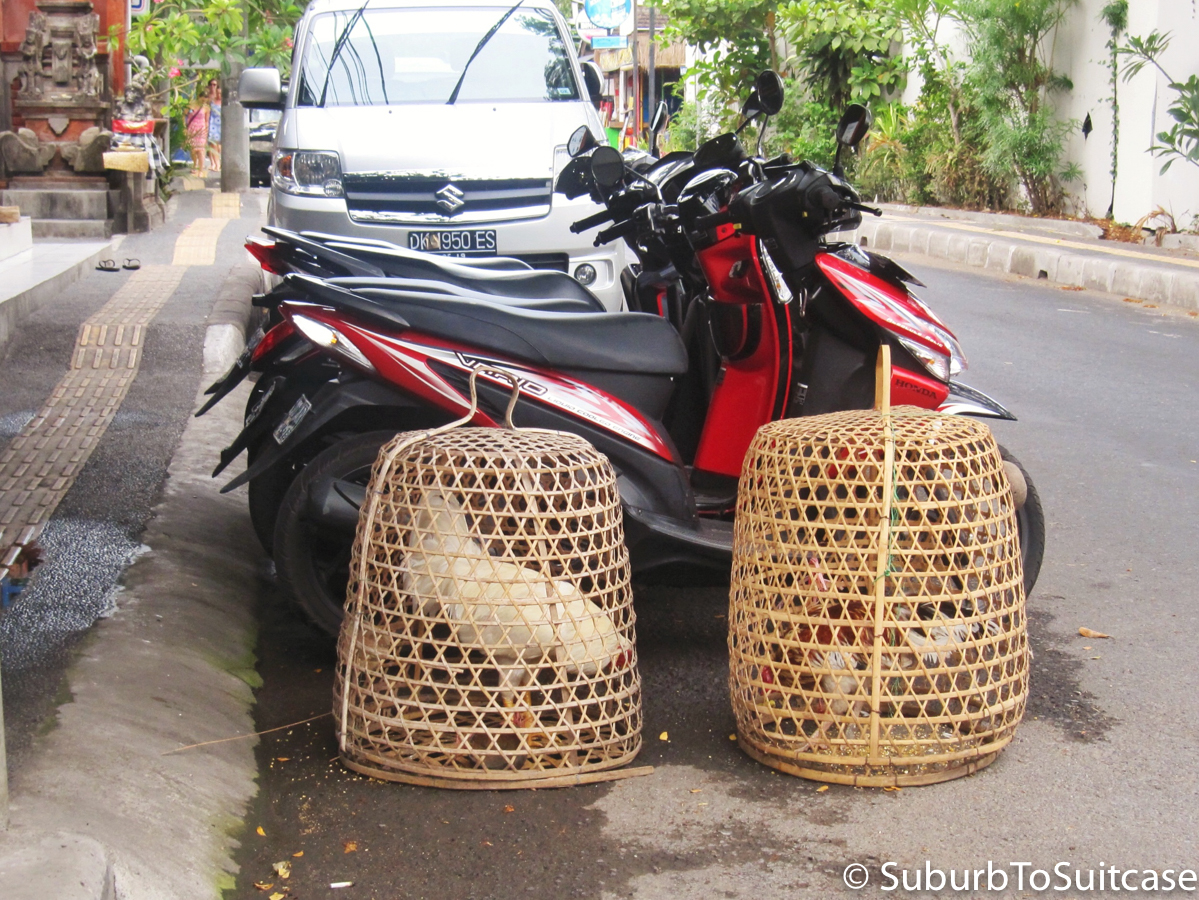
Judgment-Free Parking, Downtown Sanur
For a visitor interested in experiencing a wide variety of local culture without “roughing it,” I would recommend an Ubud tour. Staying in Ubud can be expensive (some properties are ~$500 USD per night compared to a well-appointed guesthouse in Sanur for ~$35 USD) but it is only about a 45 minute drive from Sanur and you can hire an English speaking private driver for under $50 USD for the entire day. Along the way, you can stop to see the morning Barong & Kris Dance performance (the show lasts ~45 minutes) in an outdoor theatre in the village of Batubalan. This is more of a play but it is enjoyable if you appreciate local music and culture. The cost is less than $10 USD and it supports the local community. I noticed that inside the Denpasar airport near the airline gates, there is beautifully painted artwork along the ceiling – those scenes in the airport align with the traditional dance performance and the costumes and characters will be easily recognizable.

Barong and Kris Dance Performance
There are plenty of factories and shops along the dive to Ubud where you can purchase wood carvings, silver jewelry and batik textiles. Silver is perhaps lower in price than in your local region since you are not paying the transport fees, but it is not cheap by any means. The benefit to going to the factories, though, is that you are receiving a higher quality product than in a souvenir shop and items are fixed price so there is no negotiating required. For a budget traveler, a practical low-cost souvenir is a batik sarong – they are lovely, durable and useful at any beach. Ubud is definitely geared toward tourists so you will find streets lined with very nice stores and cafes. As for outdoor interests, there are also beautiful rice terraces nearby where you can stop as well as other agricultural areas. For those who are adventurous, visit a Kopi Luwak vendor to take the short tour, taste the various coffees and teas and see the Asian Palm Civet which is the main “producer” of the Kopi Luwak. If you are lucky, you might spot the huge fruit bats which likekly reside there as well. If you are not brave enough to try the Kopi Luwak, you can also purchase traditional Bali coffee beans or delicious ginger or mangosteen teas.
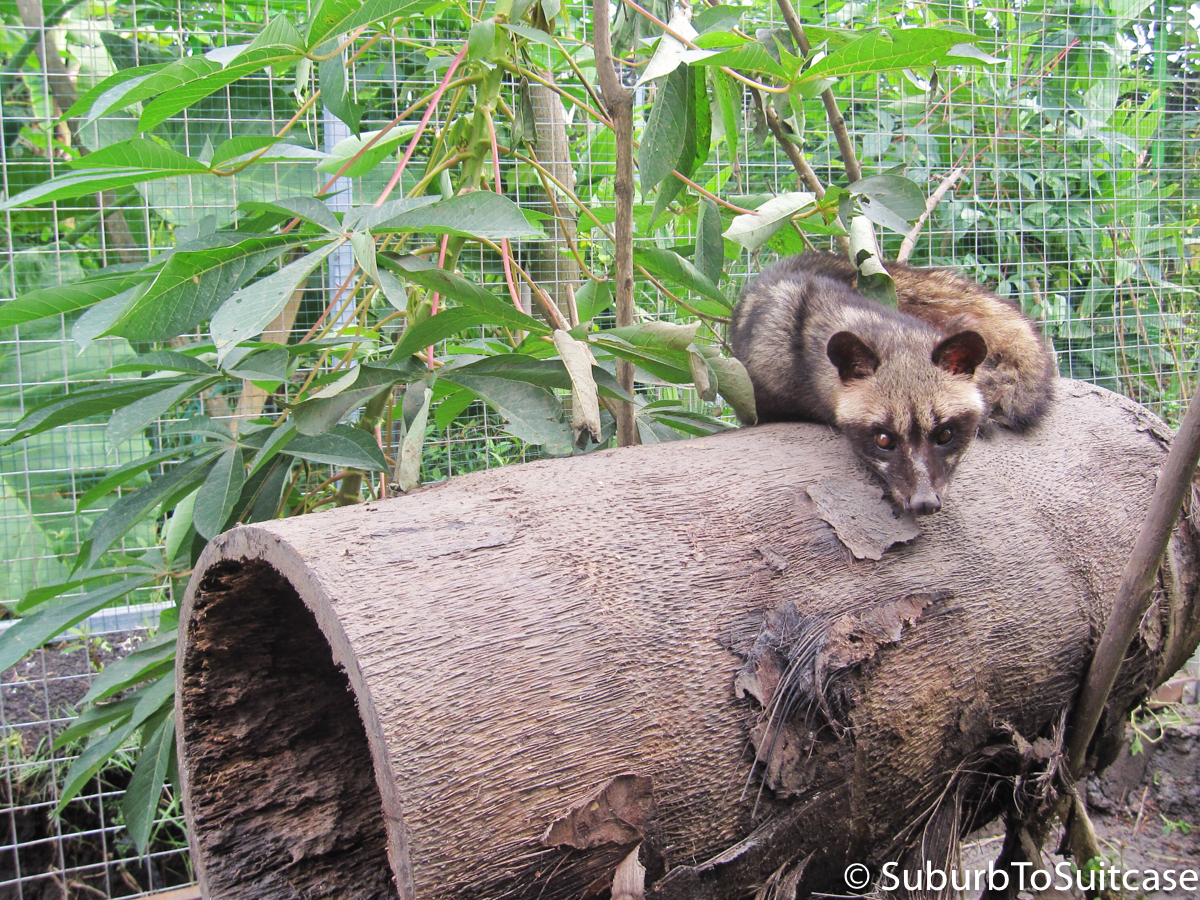
Asian Palm Civet – I rarely post photos of animals in captivity but this was a sizable pen and I understand that it is part of Indonesian culture.
The other reason to visit Ubud is to see the sacred monkey forest. Entrance is very reasonable (~$3 USD) and you can purchase bananas to feed the monkeys for a nominal fee as well. If you speak with the locals, there are a few things to keep in mind. First, those bananas are only going to last you about three meters walking and then you will have monkeys jumping all over you to get them. Give them up right away to avoid any unfortunate or dangerous situations (and dirty clothes). Also, locals will warn you to secure your sunglasses, flip flops, cameras, water bottles, etc. and remove your jewelry because the monkeys are naughty little thieves. Once they have your item, you will rarely get it back. Lastly, this is an open area – not a zoo. You are walking into a natural rainforest with lovely walking paths, a temple, etc. but these are wild animals and you are in their home. The monkeys at the beginning of the walk are the most aggressive so if you prefer a more subdued experience, skip the bananas and just keep walking until you get deeper into the jungle. There will be plenty of smaller monkeys that are curious and playful along the walk. The sanctuary staff feed the monkeys often to try to minimize their aggressiveness but if you are scared of untamed animals, this is not the place for you. Steps and a narrow path will take you down by the waterfall and stream to the holy spring. There are other places in Bali to get close up with monkeys, but I heard that Uluwatu monkeys are more aggressive so be careful in you venture there.
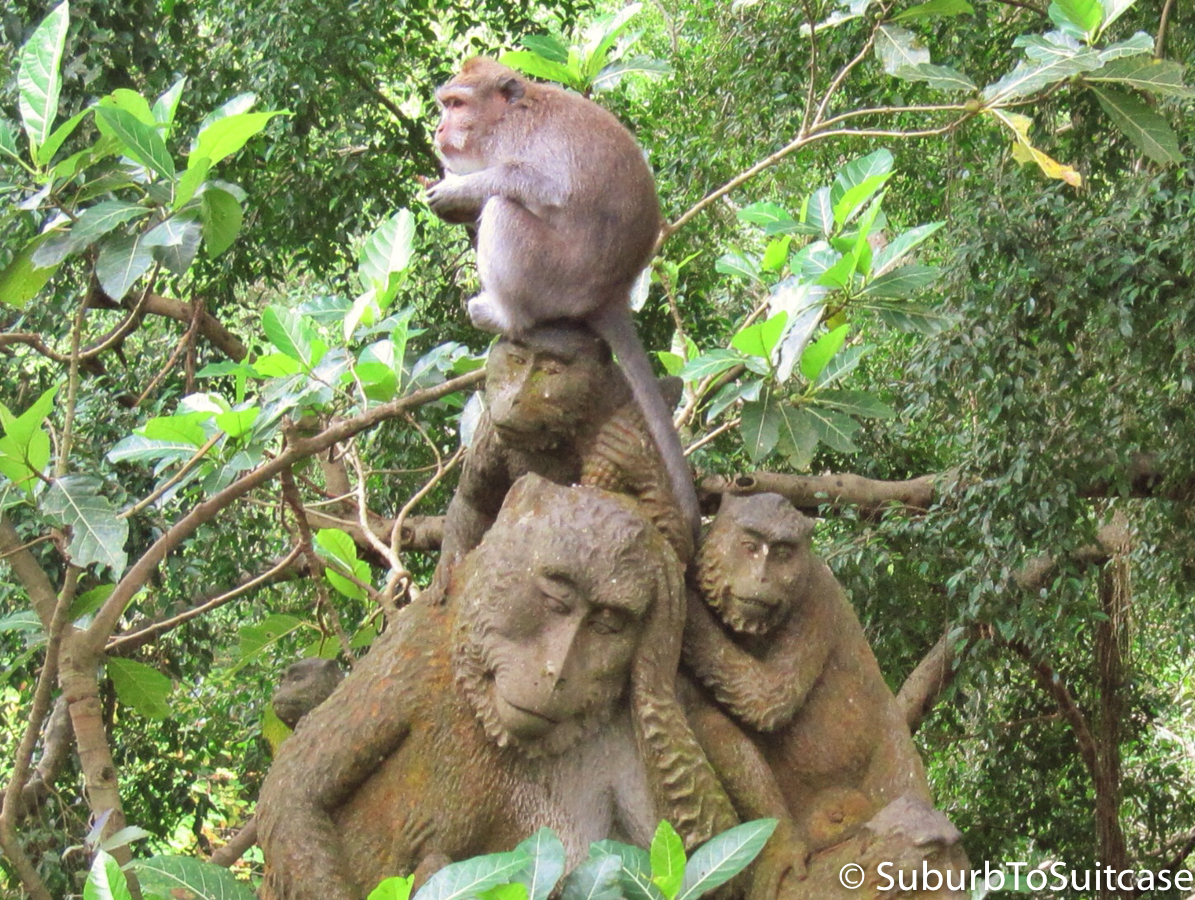
Monkeys in Ubud
There are various temples you can visit on the way to/from Ubud, but if you prefer to avoid vendors and solicitation, then Pura Puseh in Batuan is for you. There are local staff in front that will help you don a borrowed sarong and sash properly before you enter the temple to show your respect. There are cultural guidelines (especially for women) for entering a Hindu temple so it would be recommended to consider these before a visit. The months of June/July/August appear to be when the bulk of the cultural festivals and processions take place, but off-season you can still enjoy a lovely experience in Bali.

Pura Puseh Temple in Batuan
Another beautiful temple area to visit is Tanah Lot which is a rock formation in the ocean just off Bali’s West coast in the Tabanan Regency (about 30 minutes from Ubud toward Kuta/Seminyak). Depending on the weather, the sunrises and sunsets here can be magnificent. The price to enter is less than $3 USD but you do have to walk through a highly commercialized souvenir market before you reach the water. There are numerous tourists here but you still do not want to miss this site. The tide will determine how close you can get to the temple but the legend warns that the temple is heavily guarded by sea snakes. Divers probably will not be too concerned to hear this, but the typical tourist may be a little apprehensive if they spot one in the water or near the caves. Even from a distance, this is an amazing place to visit. Bring your camera and have a Bintang at the restaurant at the top and watch for the sun to set.
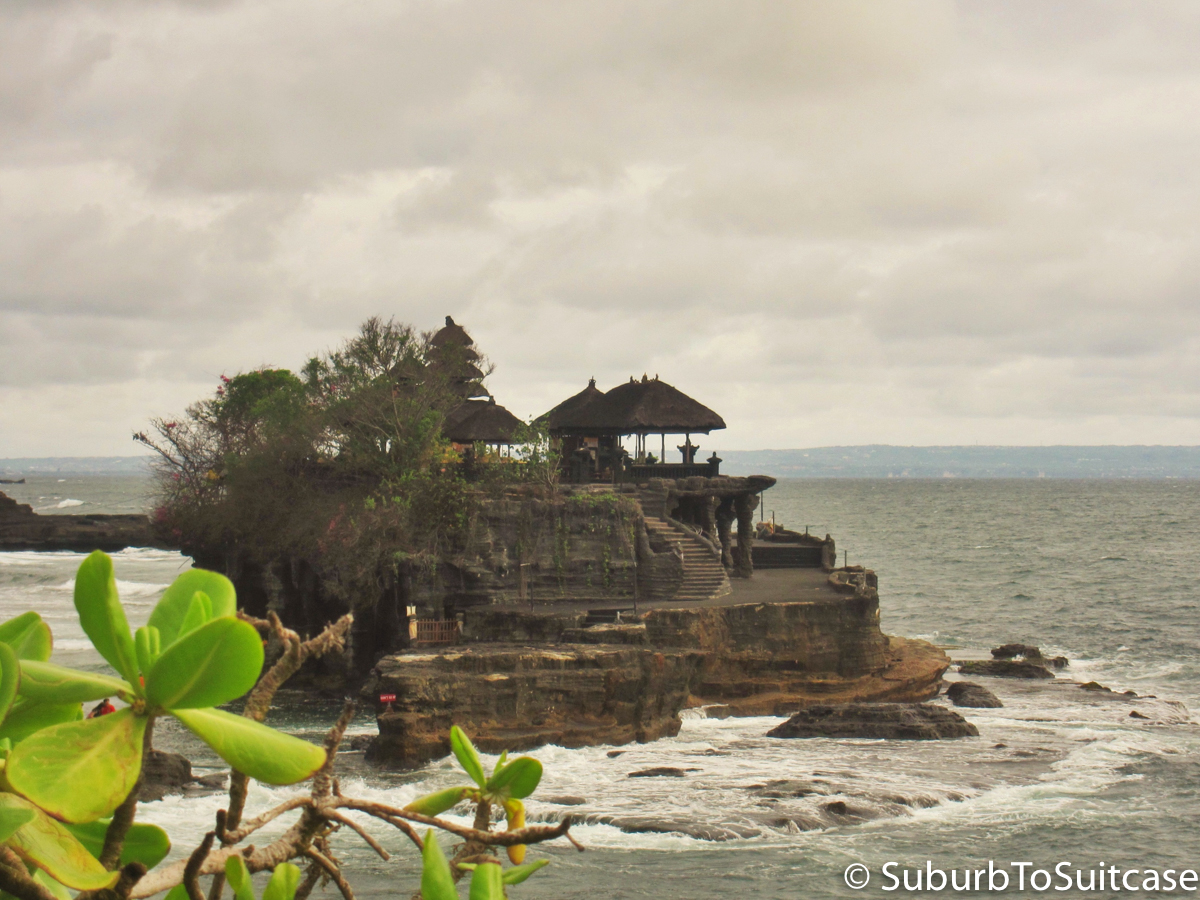
Tanah Lot Temple
And finally, carrying on my tradition of a splurge meal each trip, I did celebrate the US-based Thanksgiving holiday whilst in Bali with a meal of steamed curried fish (wrapped in a banana leaf), served atop rice, cabbage and steamed vegetables. Of course, I ate it with a plastic fork, but still – it was definitely a splurge from my usual street food or canned tuna dinners.

Steamed Fish
My other treat (during lunch at Tulamben on a different day) was Happy Soda. I honestly didn’t believe this was an actual Indonesian drink – I thought it was just some crazy concoction that my dive instructor created but it does actually exist and is called Soda Gembira. The glass is iced and filled with a small amount of strawberry syrup at the bottom then some condensed milk is poured on that. You receive a can of Club Soda (known as Air Soda in Bali) and you top off the mixture, stir with the spoon and drink through a straw. I asked Ketut one day how the name was derived. With his usual bubbly personality, he replied, “Because it makes you happy!” Well, I’m not one to ask questions so I went along with it and it actually does taste good (at least the first few sips).
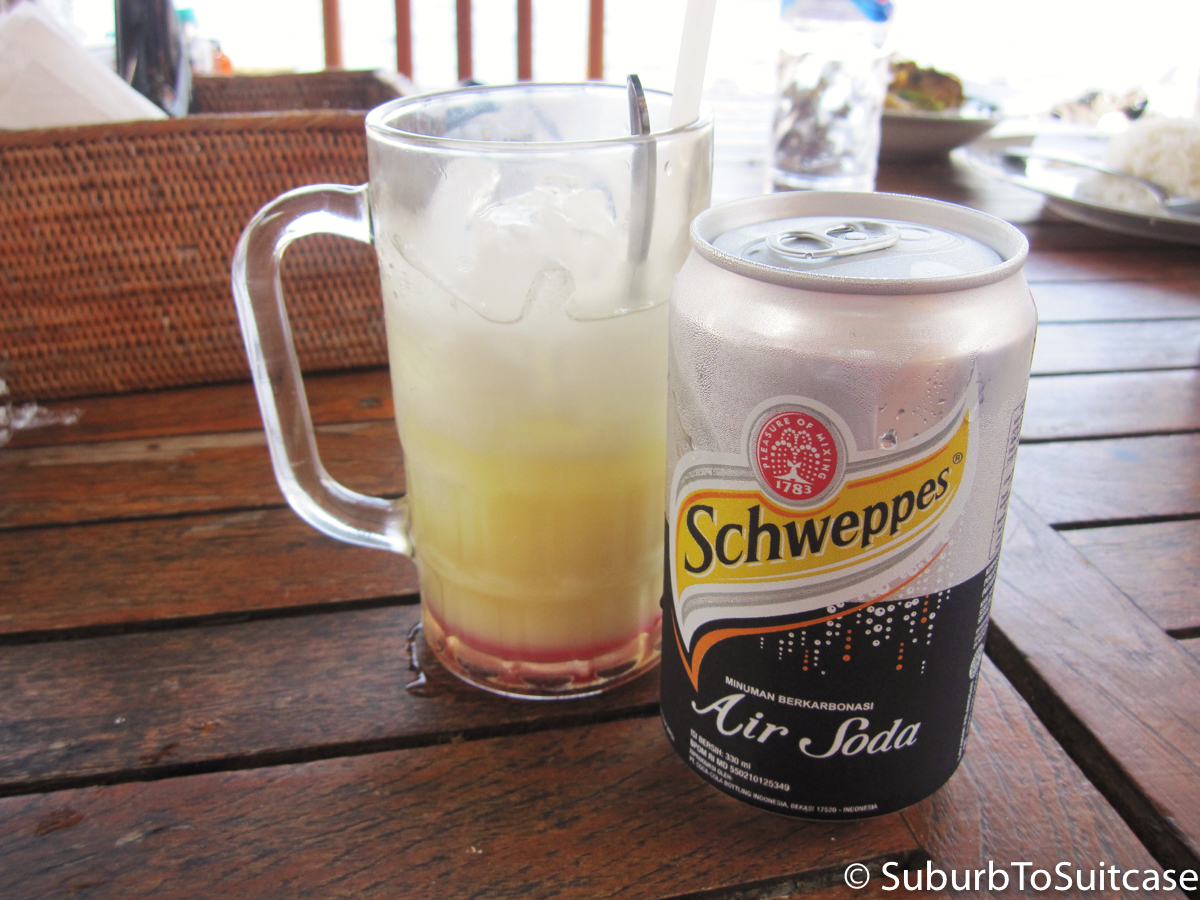
Happy Soda
Diving in Bali:
Bali dive sites accommodate a variety of skill levels – a seasoned diver who can navigate currents will acclimate quickly, whereas a less experienced diver will refine their buoyancy skills and gain experience with diverse current patterns with practice. Depending on preference, there is something to offer everyone in Bali, from wrecks to pelagics to macro life.
As for water temps, for all dives, I consistently wore 2mm capris, boots, swimsuit and long-sleeve rashguard and was comfortable. The thermoclines were significant and chilly but I have a pretty solid cold threshold so they did not bother me without a full wetsuit. I never spotted any jellyfish even in the warm shallow water, but there are some little stinging critters out there that we felt periodically on exposed skin. They never left a mark though and the stings were similar to a little itch that immediately went away. That said, you do need to watch for the fire coral – here, it resembles a light cream colored fan and it is common on the rocks and coral so be careful hovering. Also, be very careful with the triggerfish – they are extremely territorial in these waters and have no problem reminding divers of their power (and incredibly strong jaws).
My general advice would be to have a dive pointer with you since the currents are active in Bali waters and these make photography as well as some safety stops easier. Ginger lozenges are also nice to have whether for the longer travel to dive sites or for days with waves. Don’t let the rain scare you – during wet season, it often rains but the fish don’t care and it’s all the same underwater. There was never thunder or lightening during the daytime (only at night) and the rain passes very quickly. Dive site area summaries are below:
- Tulamben – Shore-entry sites such as this area on the Northeast coast offer lovely shallower dives such as the USAT Liberty wreck (originally torpedoed by the Japanese in WWII in 1942 but ultimately sunk by the nearby volcano in 1963) and Coral Garden which has an underwater temple. Cleaning stations, eel gardens, nudibranch, turtles and a wide variety of fish (barracuda, Napoleon wrasse, dog-face puffers) make these dives fun any day. The first dive I made to Coral Garden produced three awesome cuttlefish but of course, I did not have my camera – typical. While Tulamben is a two-hour bus ride away from Sanur, it is a beautiful drive through the villages and there is much to see along the way including rice terraces, monkeys, etc. The key to remember for Tulamben – especially for the wreck site – is to be sure you are in strong physical condition and stable walking over large rocks and stones along the shoreline to get to the dive site itself (the shore is not a sand beach). You will also need to pass over rocks to get through the surf into the water. Newer divers may want to practice entry and exit techniques.
- Amed – Also on the East coast of Bali and about a two-hour bus ride from Sanur, this is a great area with walls and drop-offs. You can dive from shore but the wall requires a traditional jukung boat. Most of the jukungs here are very narrow and hold about three divers plus the captain only. There are tons of octopus and sea stars and much macro life to be photographed. The coral are beautiful and there are some pretty Gorgonian fans. Currents can be strong and visibility will depend on the conditions but even in the shallows, there are areas with huge scorpionfish and underwater pyramids (home to lots of batfish). Keep an eye out for the blue spotted stingrays at the cleaning stations along the sand bottom here too.
- Nusa Penida – This site is really best suited for advanced divers due to the depth and very strong current which bring in the larger marine life. The mantas come here for the cleaning stations and when the mola mola are in season, they are found nearby as well. I loved it here because the mantas are simply spectacular to watch when they do their flips. On various dives, there were several giant mantas (both the standard white and less common solid black). Spotted two banded sea snakes here along the bottom of the reef – one quite large so that was great to find as well. The boat ride from Sanur beach requires about 45 minutes to arrive and depending on the waves, this can be quite choppy – remember seasickness meds if you are susceptible to motion sickness. You will find some thermoclines here so a full wetsuit is preferred over a shorty or rashguard.
- Padang Bai – While Nusa Penida is hard to top, my favorite dive sites were actually at Padang Bai which is about an hour drive East from Sanur. Here, you do all boat dives off the traditional larger jukungs. I absolutely love these boats. The dive sites themselves are really good for macro (unique nudis, seahorses, ribbon eels, mantis shrimp) but there are also large fish (cuttlefish, triggerfish, HUGE lobsters, etc.) that appear as well. This is where I finally found the gurnard too (I’d been wanting to spot a “sea robin” for a long time and never had any luck in the Caribbean). I think it was the large variety of sea life at these sites that made me enjoy it here so much. There are some thermoclines here to be aware of. Padang Bai is a popular ferry port for visitors traveling to the Gili Islands and also Lombok.
One thing is for sure – no matter which sites you choose to dive in Bali, they will be a wonderful experience. Bring an underwater camera, consider gaining your wreck specialty or just enjoy the beautiful underwater surroundings! If you are interested in seeing my underwater photos from Indonesia, here is a link to my Indonesia underwater gallery. If you are interested in critter identification, you can check out my identification page where nudibranchs, sea hares, sea slugs, cowries, opisthobranchs, etc. are grouped by primary color.
Travel Tips:
- If you need to spend the night in Taipei Taoyuan International Airport (TPE) on your way to Denpasar, be sure you have warm clothes or a blanket in your carry-on bag. This is the coldest airport I have ever experienced anywhere in the world. At night, the airport is nearly empty, but the China Airlines transfer counter has a small seating area with super clean restrooms, shower facilities, accessible electrical outlets and even a purified hot/cold water machine that works all night. Several of us slept here, including the night attendant and I felt very safe.
- The Denpasar airport (DPS), on the other hand, is primarily open-air style and if you arrive during wet season, you will certainly not be cold. There is a luggage holding area out front where you can pay a small fee per bag to store your bags while waiting for your return flight if you do not want to keep them with you. The taxi drivers are very aggressive and will pester you while you walk even if you are not leaving the airport, but once you get past them, all is peaceful. The airport has strong wi-fi but very little seating (as in, next to none). If you can find a table at the Bintang restaurant and have a snack, they will let you sit on their comfortable sofas for hours waiting for your airline counter to open. Once your flight counter opens (three hours before your flight) and you are able to get through security, the airport has plenty of comfortable seating, food and shops. On my first trip to Bali, there was a requirement where a traveler needed to pay a departure fee in Indonesian Rupiah (IDR) to leave Denpasar by air. Travelers would pay this fee (~200,000 IDR) in exact bills at a counter before going through security. I have since returned to Bali and did not have to pay the exit fee. I read that the rules changed and this is automatically charged to you in the price of your airline ticket. So, just something to watch for in case rules change.
- Taxis in Bali are also notoriously corrupt. Bluebird Taxi is reputable and was the only taxi company recommended consistently. They have meters inside the cars that are visible to passengers and you can see when they are cleared out. Other taxis that are blue in color are not the same company – Bluebird will always be noted on the outside doors. Taking any other company can exponentially increase your rate. For point of reference, a taxi from Sanur to DPS airport in a Bluebird taxi in traffic will only cost ~$12 USD.
- For those staying in Bali, currency exchanges are called “money changers” and these are not consistently ethical either. Avoid stores that have an added money changing area – just use those that are dedicated money changers and only go to those that are well lit with counters up front. Those where you walk down a dark hallway, etc. will skim money from your transaction by dropping bills. Ethical money changes will have slightly lower exchange rates but that is because they will actually give you all your money in exchange. They will have big blue or green signs in front of their storefronts and post all exchange rates out front (hint: they do not sell souvenirs). Be sure you get small bills since most vendors sell inexpensive items.
- Most everything in Bali is very reasonably priced but depending on your travel style, this can certainly vary. Budget travelers and backpackers can have a great experience. While a meal in a tourist-focused restaurant can mirror the price in your home region, local street food is so inexpensive. A piece of chicken with more rice than you could possibly eat will run you ~11,000 IDR (less than $1 USD) and a mango is ~4,000 IDR. A more balanced meal in a local restaurant costs not much more than that and it will include your choice of meat (generally a curry based chicken dish), cabbage and other local cooked vegetables and side dishes. The more open you are to trying new things, the more culturally immersed your experience will be.
- There are numerous tour operators in Bali. Those with storefronts or stands in tourist areas have negotiable prices. My recommendation is a private driver for hire – most sell their dedicated time for 4 or 8 hour blocks. An English speaking driver will charge more than a local driver but I had pleasant experiences with both. If you purchase a tour package, be sure you know what this covers. For example a private English speaking driver may charge $50 for the day but if you are going to areas such as Ubud, you will also pay small charges for toll-style roads (roadside guards will collect money on certain roads), parking at tour sites, attractions (e.g., monkey forest), lunch, etc. These are not alarming amounts, but they are in addition to a base price. Private beaches also charge for seating.
- If you decide to rent a motorbike in Bali, be sure you carry your papers. We passed a few checkpoints where each vehicle was stopped to check licenses since there are so many undocumented drivers. Fines are steep for infringements. Also, keep in mind that driving conditions and common practices may be very different from your local area, especially with motorbikes. Drivers seem very courteous but the speed is fast, the roads are uneven/narrow/shared, passing can be abrupt, traffic lights and stops are few and far between and the only real rules I could discern were (1) motorbikes stay left and (2) honk gently any time you are going to do seemingly anything (truly, anything).
- Pharmacies in Bali are called “Apoteks” (or “Apotiks”), should you need medicine during your stay. A prescription is not necessary for an antibiotic if you know what you need but there are physicians available if required. Like other vendors, some chemists are more ethical than others with their pricing for tourists. When in doubt, ask someone you trust for a reputable location.
- If you are traveling from Indonesia to Australia, be careful what you purchase as souvenirs. Verify with your next destination what you can and cannot import before purchasing so you do not have to forfeit your goods at customs. There are a number of countries that prohibit certain items such as coffee, wood materials, etc. I had no issues bringing small souvenirs back to the US.
- Consider packing comfortable/practical shoes (e.g. hiking sandals) in addition to flip-flops. Streets (especially sidewalks) in Bali are uneven and there are often sinkholes and missing concrete patches. When it rains, streets often flood and flip-flops can easily swim away if you are crossing a wet road. Also, stone paths can become very slick so destinations like Tanah Lot can be hard to walk through once the rising surf gets your flip-flops wet. If you plan to ride a motorbike/scooter, flip flops can be unstable.
- Generally speaking, Bali is very safe. As with any destination, just be aware of your surroundings, avoid being a target for pickpocketing and be cautious how much personal information you share if you are a woman traveling alone. Obvious as it may seem, be very careful with the arak unless you know your server!
- Depending on your tolerance for cultural diversity and outdoor volume, choose your accommodation location carefully. Balinese villages are predominantly Hindu and Muslim so there are cultural traditions that involve activities at different parts of the day and night. Either embrace those routines or choose an area that is more comfortable for you. Also, take care when you walk in Bali not to step on one of the offering baskets or near the baskets (e.g., the crackers near this one). You will see these placed in front of residences and businesses at different times of the day and they all have cultural significance.
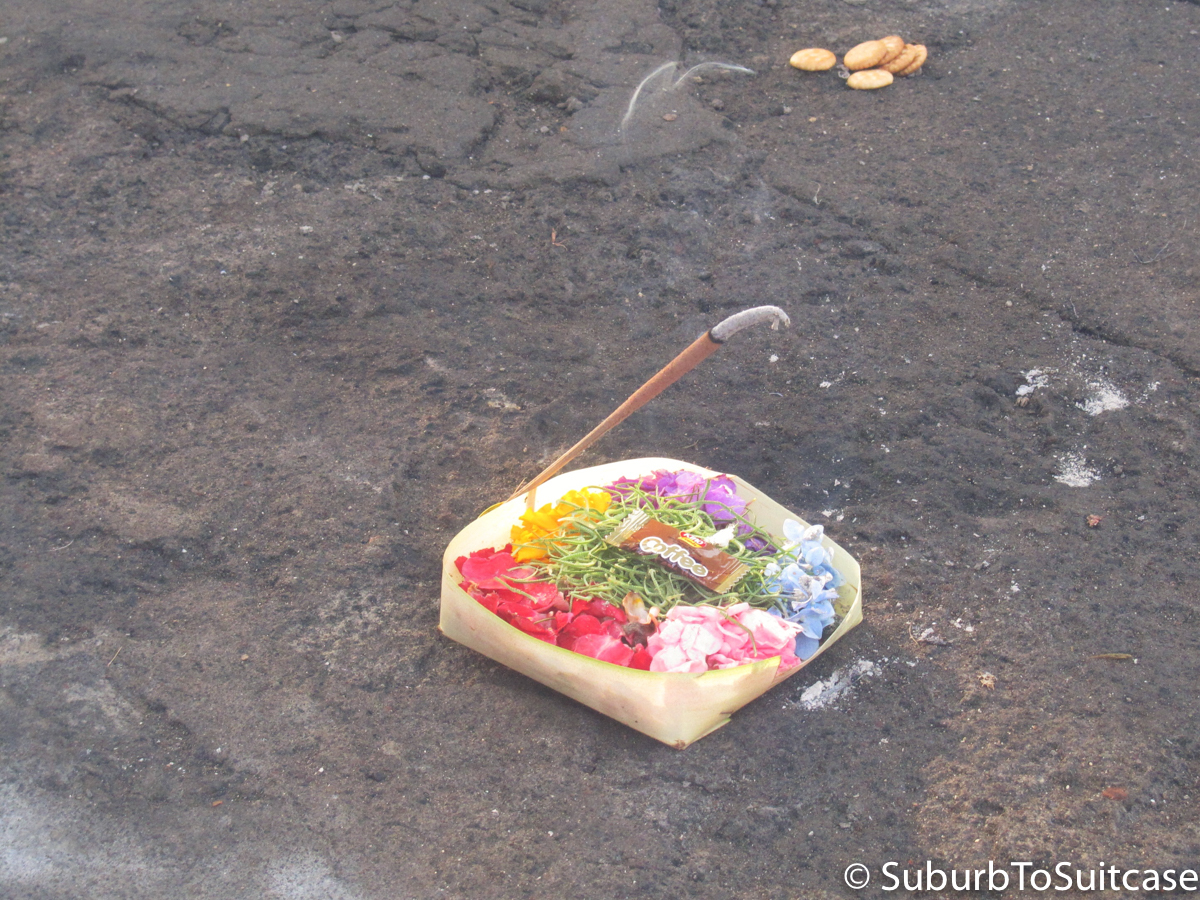
Canang Sari Offering

